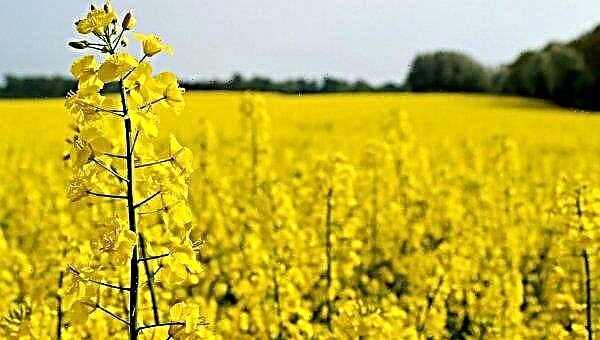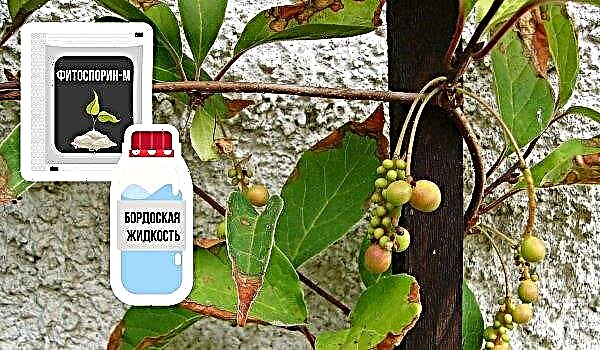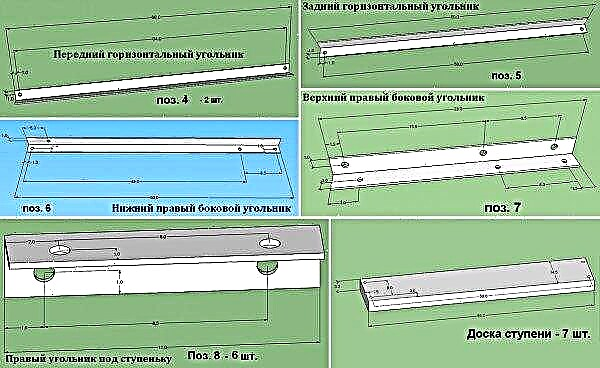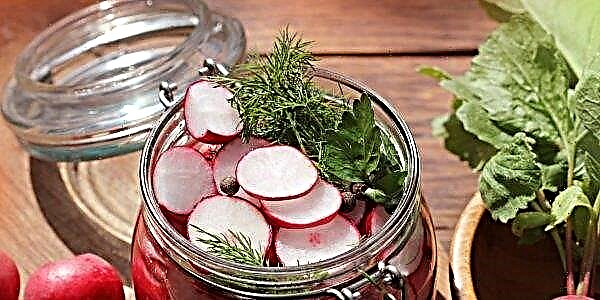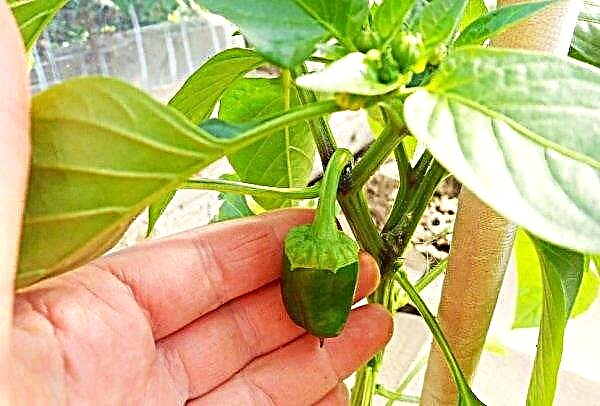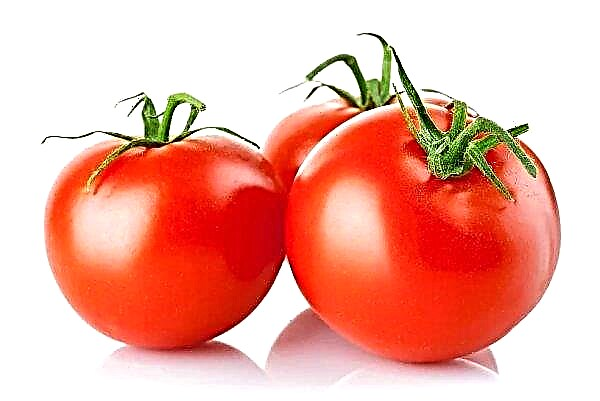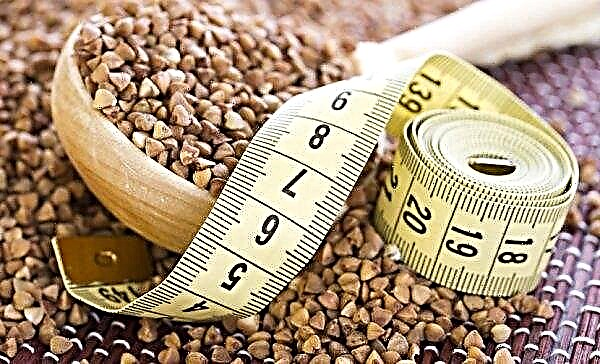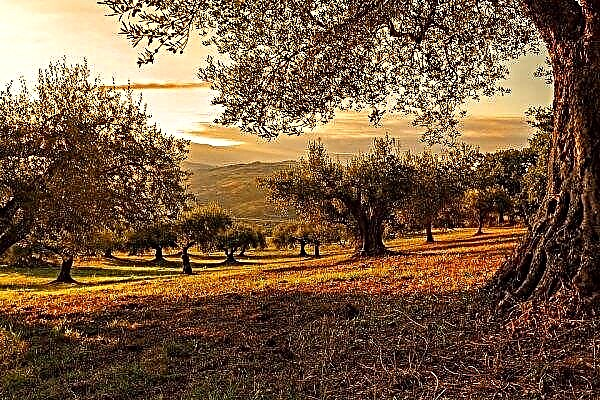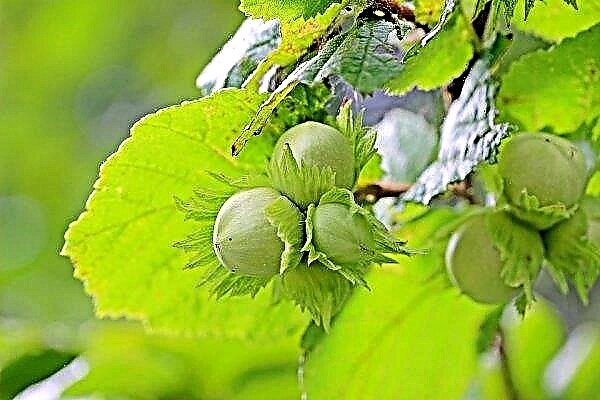Hay is an essential ingredient in a cow’s diet throughout the year. However, there are times when an animal refuses to consume it. For what reasons this happens and how to get out of the situation, we will tell in the article.
Feed Characterization
Like any other animal, a cow needs a varied and balanced diet that will replenish the body with the necessary elements so that it is notable for good health and high productivity. It is primarily a question of the balance of basic and concentrated feed.
Cows must include coarse, succulent, green feeds and concentrates on the menu.
Did you know? In the world, several miniature breeds of cows were bred that did not exceed 1 m at the withers. One of them appeared in Africa - representatives of the Shorthorn breed were 80–100 cm tall and 150–200 kg in weight. In Mexico, a farmer bred a cow that was 62 cm tall and brought a liter of milk per day.
Rude
Coarse feed includes hay and straw. Every day, a dairy cow needs up to 4–5 kg of roughage — this indicator depends on the season, the amount of milk brought in and the availability of other types of feed in the diet. For breeds of meat, coarse foods should be 30% of the total diet. At the same time, 40% should be represented by succulent feed and 30% by concentrates. Also, the calculation can be carried out based on the norm of 2 kilograms per 100 kg of live weight.
These products are vital for cattle, as they saturate the body with protein, fiber, vitamins, calcium and phosphorus. And this, in turn, has a positive effect on the functioning of the digestive tract, the course of metabolic processes, productivity, general well-being and weight gain. The nutritional characteristics of hay depend on which plants it was harvested from and under what conditions it was preserved. The most useful are dried cereals and legumes.
The nutritional characteristics of hay depend on which plants it was harvested from and under what conditions it was preserved. The most useful are dried cereals and legumes.
If the cow does not have enough hay, then straw is introduced into the diet. It contains a sufficient amount of fiber, but few vegetable proteins and no minerals and vitamins.
Straw made from winter crops is prepared in a special way before feeding, because it is too hard. Barley and oats straw is given as feed without preparation.
Important! When poisonous and prickly grasses get into the hay, its quality is significantly reduced: such food can lead to poisoning of animals. Also, intoxication provokes hay, which was stored incorrectly - in conditions of high humidity and lack of air ventilation.
Green
The main diet of cattle must include fresh grass. Adults are able to consume up to 70 kg of grass per day.
Green feed contains proteins, amino acids, vitamins, and minerals necessary for the normal functioning of the animal’s body. However, their main advantage is that they are perfectly absorbed by the cow's digestive system. The most valuable and highly nutritious green forages are young meadow grasses mixed with legumes. Only with a sufficient amount of this type of feed in the diet of a cow can one count on its maximum productivity, high-quality and tasty milk, and resistance to disease.
The most valuable and highly nutritious green forages are young meadow grasses mixed with legumes. Only with a sufficient amount of this type of feed in the diet of a cow can one count on its maximum productivity, high-quality and tasty milk, and resistance to disease.
Juicy
The succulent feeds that cows give are silage (from corn and sunflower), haylage (a mixture of annual, perennial herbs with legumes), root and tubers (potatoes, beets, carrots) and melons (watermelons, pumpkins). This type of feed is required in the winter. It allows you to maintain a high level of milk yield, maintain a strong immune system, make up for water deficiencies, improve the digestibility of other types of feed. Haylage also replenishes sugar and carotene.
The recommended rate of succulent feed in the diet of cattle is 4-5 kg per day.
Concentrated
Concentrated feeds include cereals, production waste (cake, meal, bran, beet pulp, flour), as well as animal feed. They are highly nutritious and indispensable in the preparation of the diet of cows, which require good milk yield or meat yield.
For dairy cows there are the following standards for the consumption of concentrates:
- with a daily milk yield of 10-15 kg - 100-150 g per kg of live weight;
- with milk yield 15–20 kg - 150–200 g / kg;
- when milk yield is 20–30 kg - 200–300 g / kg.

Waste production
Cattle feed includes waste from flour, cereal, beet-sugar, and oil production. They are necessary for replenishing the animal’s body with vitamins and minerals, as well as protein and fiber. Wheat, rye, corn, pea bran, fodder flour, mill dust, beet pulp, molasses, hemp, sunflower, flaxseed cake, meal are introduced into the diet.
The amount of these ingredients will depend on a balanced diet, in particular, on a balance in mineral composition.
Why does the cow not eat hay and what to do
Hay must be in the diet of the cow, regardless of the period. However, it happens that cows refuse to consume it. This can happen for several reasons, a description of which you will find below. We also give methods on how to make an animal eat in the previous mode.
The impact of disease
Often, cattle refuses roughage if she is unwell. There are several diseases that lead to disruption of the digestive tract and a decrease or loss of hunger. In order to restore appetite and establish digestive function, it is necessary to establish the cause of the problem and eliminate it.
Tympany
This is a bloating of the pancreas or scar due to excessive gas formation in the digestive system or obstruction of food to the stomach. Symptoms
Symptoms
- anxiety;
- frequent attention of the cow to the stomach;
- lack of appetite;
- enlargement of the abdomen on the left side;
- swelling of the scar;
- cessation of ruminant function;
- fever.
- eating in large quantities of products that tend to ferment (greenery of corn, beets, cabbage, winter shoots);
- uncontrolled grazing on wet pastures;
- irregular feeding of animals, as a result of which they eagerly eat food, not having time to chew them normally;
- an unbalanced diet and the wrong frequency of feeding;
- keeping animals without walking.
Ways to increase your appetite:Important! All emergency methods and the appointment of drugs should be carried out by a person with a veterinary education and only after the correct diagnosis.
- Eliminate the causes of scar inflammation - establish nutrition, control the quality of feed.
- Remove gases by introducing the probe and flushing the scar or, in emergency cases, puncture it.
- To stop the fermentation processes by the introduction of disinfectants (iodine, ichthyol, formalin, etc.).
- Perform a scar massage.

Atony
Manifested by a decrease and cessation of contractile activity of the scar.
Causes:
- providing cows with feed that is difficult to digest;
- ingestion of low-quality products;
- a sharp change in the types of feed, for example, green concentrated;
- drinking dirty water.
- a sharp decrease or loss of desire to eat;
- lack of chewing gum or its too liquid consistency;
- weak pulsation of the pancreas;
- compaction in the pancreas;
- a change in the nature of feces to liquid;
- drop in productivity.
 Ways to increase your appetite:
Ways to increase your appetite:- Do not give the animal food throughout the day, while drinking plenty of water.
- Introduce from the 2nd day only high-quality food with a small inclusion of animal feed.
- Regularly take the animal for a walk.
- Carry out a scar massage.
- Water with glauber salt dissolved in water (200 g / 1 l).
- Introduce vegetable oil (800 g) into the diet.
Mastitis
Diseases of the udder, in particular mastitis, may also be the cause of changes in food preferences or lack of appetite. This disease is caused by streptococci and staphylococci, which penetrate through the milk channel and wounds.
Causes:
- ignoring udder care, hygiene during milking;
- poor bedding after calving;
- difficult birth;
- damage to the mammary glands.
- the presence of seals, nodules in the mammary glands;
- the presence of cereal, protein, pus, blood in milk;
- increase in body temperature;
- decrease in milk yield;
- oppression;
- lack of appetite.
 Ways to increase your appetite:
Ways to increase your appetite:
- It is necessary to treat the disease with injections of suspensions and antibiotics (Mamifort, Mast Weixim, Dorin, etc.).
- Use homeopathic ointments and vaccines (Traumeel, Echinacea compositum, etc.).
- Properly express milk every 2 hours.
- To wash the mammary glands with cold water 5 times a day.
- To relieve inflammation and alleviate the condition, apply cabbage leaves, compresses (clay + olive oil + water), beet-honey mixture (3: 1) to the glands.
- Reduce the amount of juicy and concentrated foods in the diet and increase the percentage of hay.
Ketosis
If metabolic processes are disturbed, the body accumulates ketone substances, inflammation of the liver, heart, kidneys and other internal organs.
Causes:
- improperly prepared diet, in particular, an excess of concentrates, a lack of rough and succulent feed;
- lack of walks;
- protein overfeeding in combination with low physical activity during milking.
 Symptoms
Symptoms
- excitation of the nervous system, which is then replaced by oppression;
- trembling in the body;
- gnashing of teeth;
- increased salivation;
- preference for poor-quality feed (for example, eating rotten hay, bedding instead of good feed);
- smell of acetone from the mouth, from milk and urine;
- reduction in the amount of milk or its complete absence.
Ways to increase your appetite:
- Adjust the feeding regimen - reduce the number of concentrates and increase the percentage of hay, haylage, succulent feed, introduce molasses.
- Introduce premixes, intravenous vitamins, minerals into the diet.
- Introduce intravenously glucose (300-600 ml). With prolonged glucose treatment, inject insulin. Or drink with sugar syrup (150-500 g of sugar dissolved in water).
- Apply energy.
- Conduct soda enemas or drink soda solutions.
Traumatic reticulitis
This is an inflammation of the second pancreas due to a foreign body entering the digestive system. Symptoms
Symptoms
- restless behavior;
- increase in body temperature;
- rapid pulse;
- loss of hunger;
- cessation of scar pulsation;
- a noticeable decrease in the amount of milk delivered.
- It is necessary to remove a foreign body (if possible).
- Before removal, put the animal on a hungry diet lasting 1-2 days.
Helminth infection
One of the most common reasons for reducing hunger or eating habits in cattle is worms. The reason is the ingestion of worms in the body with grass contaminated with water. Symptoms
Symptoms
- cough;
- increased sweating in the morning;
- fastidiousness when eating food;
- a sharp decrease in body weight;
- reduction in the amount of milk brought;
- alternating constipation and diarrhea.
Postpartum and Prenatal Paresis
If the cow stopped eating hay immediately after calving, then, most likely, she has postpartum complications. Most often, such symptoms are characterized by postpartum and prenatal paresis, the causes of which are metabolic disorders. They are accompanied by symptoms such as paralysis of the legs, tongue and larynx, problems with the digestive system, weakness, impaired coordination of movements, lethargy, and fever. Postpartum paresis: 1 - severe; 2 - mild form. If such a condition arose before calving, then the cow will not be able to help. Paresis after childbirth occurs in the period from 1 to 3 days. It is treated with caffeine injections and pumping air of the mammary glands through the nipple to increase pressure in it and change chemical reactions in the body, normalize the levels of calcium, magnesium and glucose. Complementary therapy consists of warm enemas and injections of a mixture of calcium chloride, glucose and water into a vein. Intramuscular injections of hormonal drugs, dihydrotachysterol, intravenous injections of calcium gluconate solution are effective.
Postpartum paresis: 1 - severe; 2 - mild form. If such a condition arose before calving, then the cow will not be able to help. Paresis after childbirth occurs in the period from 1 to 3 days. It is treated with caffeine injections and pumping air of the mammary glands through the nipple to increase pressure in it and change chemical reactions in the body, normalize the levels of calcium, magnesium and glucose. Complementary therapy consists of warm enemas and injections of a mixture of calcium chloride, glucose and water into a vein. Intramuscular injections of hormonal drugs, dihydrotachysterol, intravenous injections of calcium gluconate solution are effective.
Other reasons
Other possible causes of a lack of hunger include:
- poisoning by vegetation or chemicals;
- overfeeding;
- a sharp transition to new types of feed;
- living in unsanitary conditions;
- the provision of poor-quality feed;
- violation of the regime and rules for the provision of food.
Why the calf eats hay badly
Some breeders of cows are faced with the fact that hay refuse to eat small calves. As a result, they do not gain weight, and the owners have difficulty in selecting products for the baby. In order for the calf to start eating normally, you should understand the reasons for his refusal to eat. To begin with, it is necessary to exclude congenital pathologies, which include white muscle disease, paratyphoid, pneumonia, inflammation of the gastric mucosa, hernia. To determine the exact cause, it is necessary to show the baby to the veterinarian without appetite.
In order for the calf to start eating normally, you should understand the reasons for his refusal to eat. To begin with, it is necessary to exclude congenital pathologies, which include white muscle disease, paratyphoid, pneumonia, inflammation of the gastric mucosa, hernia. To determine the exact cause, it is necessary to show the baby to the veterinarian without appetite.
Common causes are also colds. If the calf's body temperature is elevated, then most likely he has caught a cold and he needs to be given veterinary care.
Another reason why the baby refuses to eat roughage is that he only ate his mother’s milk recently and simply doesn’t know what hay is, what he can eat and how to do it. In this case, you need to wait a bit for the calf to adapt to a new type of food. The training of calves for fresh hay does not begin before they reach 20 days: they do it aggressively, constantly leaving it in the feeder or feeding it by hand.
According to the norms, at the age of 2-3 months, the calf should eat about 1 kg of hay, at 4 months - 3 kg, at 5 months - 4 kg, at 6 months - 5 kg. If no health problems have been identified, then the owner needs to make a diet without hay, and offer the product in question a little later, when the calf grows up. You can also try replacing the feeder - perhaps from the one that is provided to the calf today, it is simply uncomfortable to eat. It is necessary to pay attention to the quality of hay - young individuals should be given only fresh and soft.
You can also try replacing the feeder - perhaps from the one that is provided to the calf today, it is simply uncomfortable to eat. It is necessary to pay attention to the quality of hay - young individuals should be given only fresh and soft.
Did you know? Usually a cow brings one, maximum two calves. However, there are unique cases when females gave birth to 5 and 8 babies. And in 1939, the cow brought a record number of calves for 1 calving - 16. But, unfortunately, only 1 of them was full-term.
Thus, there are many reasons why a cow refuses to eat. Most often this is due to the development of a disease. To establish the activity of the digestive system of the animal, it is necessary to identify the cause and eliminate it. Entrust this task to a competent veterinarian.

